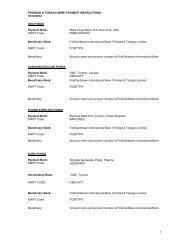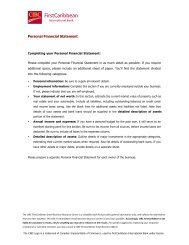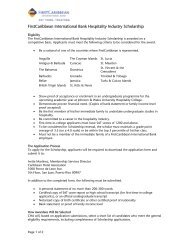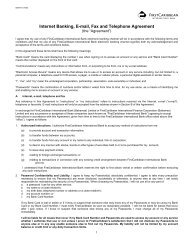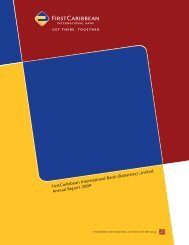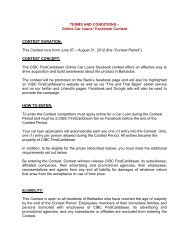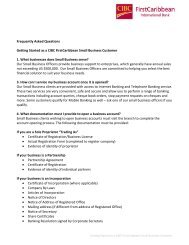Bahamas - FirstCaribbean International Bank
Bahamas - FirstCaribbean International Bank
Bahamas - FirstCaribbean International Bank
- No tags were found...
You also want an ePaper? Increase the reach of your titles
YUMPU automatically turns print PDFs into web optimized ePapers that Google loves.
FIRSTCARIBBEAN INTERNATIONAL BANK (BAHAMAS) LIMITEDNotes to Consolidated Financial StatementsOctober 31, 2002(expressed in thousands of Bahamian dollars)1 General informationThe <strong>Bank</strong>, which was formerly named CIBC <strong>Bahamas</strong> Limited (“CIBC <strong>Bahamas</strong>”) and controlled byCanadian Imperial <strong>Bank</strong> of Commerce (CIBC), changed its name to <strong>FirstCaribbean</strong> <strong>International</strong> <strong>Bank</strong>(<strong>Bahamas</strong>) Limited on October 11, 2002, following the combination of the retail, corporate andoffshore banking operations of Barclays <strong>Bank</strong> PLC in the <strong>Bahamas</strong> and the Turks & Caicos Islands(“Barclays <strong>Bahamas</strong>”) and CIBC <strong>Bahamas</strong>.The <strong>Bank</strong> is a subsidiary of <strong>FirstCaribbean</strong> <strong>International</strong> <strong>Bank</strong> Limited, formerly CIBC West IndiesHoldings Limited (the “Parent”), a company incorporated in Barbados with the ultimate parentcompanies being jointly CIBC, a company incorporated in Canada, and Barclays <strong>Bank</strong> PLC, a companyincorporated in England.Under the combination, shares issued to Barclays <strong>Bank</strong> PLC for the Barclays <strong>Bahamas</strong> operations wereexchanged for shares in CIBC West Indies Holdings Limited which remained the legal parent companyof the <strong>Bank</strong>. Following the combination, Barclays <strong>Bank</strong> PLC and CIBC each own 45% of the votingshares of the Parent. Neither Barclays <strong>Bank</strong> PLC nor CIBC control the Parent, but <strong>International</strong>Accounting Standards (IAS) requires that one of the combining entities be identified as the acquirer foraccounting purposes. The fair value of the Barclays’ business prior to the combination was greater thanthe fair value of CIBC’s business and, as a result, Barclays had the greater economic interest in theParent. Barclays was therefore identified as the acquirer. This situation is described by IAS as a reverseacquisition.Accordingly the financial statements of the <strong>Bank</strong> are presented as a continuation of the financialstatements of Barclays <strong>Bahamas</strong> and on the basis that Barclays <strong>Bahamas</strong> acquired CIBC <strong>Bahamas</strong> onOctober 11, 2002. The financial statements have been prepared as at October 31, 2002, the accountingreference date of CIBC <strong>Bahamas</strong>. The comparative amounts disclosed in the financial statements arethose of Barclays <strong>Bahamas</strong> as at and for the year ended December 31, 2001. The consolidated incomestatement includes the results of Barclays <strong>Bahamas</strong> for the period from January 1, 2002 to October 31,2002, together with results of the CIBC <strong>Bahamas</strong> subsequent to the combination. The consolidatedbalance sheet at October 31, 2002 reflects the assets and liabilities of Barclays <strong>Bahamas</strong> at book valueand the assets and liabilities of CIBC <strong>Bahamas</strong> based on their fair value at October 11, 2002 as adjustedto reflect movements in the period to October 31, 2002.Note 24 describes the accounting treatment applied to the acquisition.The registered office of the <strong>Bank</strong> is located at 308 East Bay Street, Nassau, The <strong>Bahamas</strong>. At October 31,2002 the <strong>Bank</strong> had 843 employees.53



